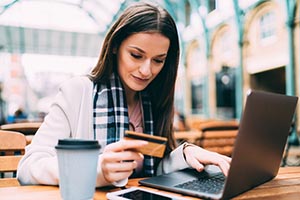Brush up on your AI knowledge with this list of key terms and their definitions from the U.S. Bank innovation team.
Artificial intelligence (AI), while an increasingly headline-grabbing topic, can still seem like science fiction for many organizations. Unless you work with AI or machine learning on a daily basis, you might think AI only happens in Steven Spielberg movies, but it’s becoming increasingly leveraged at U.S. Bank and across financial services.
I recently joined the U.S. Bank innovation team, and am leading Artificial Intelligence and Machine Learning practice at the bank. Key parts of that role include helping showcase the “art of the possible” and driving near-term pilots that help us seamlessly deliver the whole bank for our customers with AI.
While I spend most of my days working on AI-related projects, many of our clients are just beginning to understand the potential of AI. To help level-set on what AI is, let’s clarify and define some of the most common terms you may have heard. This list is certainly not comprehensive, but I hope it’ll provide a bit of grounding as your company considers applying AI to business opportunities.
Starting at the top: Broad terms and definitions
The term Artificial Intelligence is often confused with related fields that leverage statistics and software engineering so it’s helpful to consider how they vary by process, outcomes and insights. Here’s a simplified representation of the landscape:
- Data science generates knowledge and insights
- Machine learning identifies patterns and enables predictions from data
- Artificial intelligence produces actions that were believed to require human intelligence
Here’s a broad look at each of these fields.
Artificial intelligence
You probably already understand the term “artificial intelligence” in a broad context — it refers to the application of computational tools to complete tasks that normally required human intuition and judgment. AI is being used in almost every major industry, including personalizing music playlists at Spotify, predicting what movie you should watch on Netflix, and enabling you to check your U.S. Bank checking balance with an Amazon Echo.
For financial services, banks use AI for everything from mobile check deposits to process automation. It’s also become a vital payments tool for fraud protection and anti-money laundering (AML), among countless other uses.
Machine learning
Machine learning allows software systems to automatically “learn” based on patterns identified in new data, not predefined code.
- Machines mimic the human mind’s ability to learn and adapt by itself, without significant interference from a human programmer.
- There are several subfields of machine learning, derived from a recent report by the Financial Stability Board:
- Supervised learning: Generally involving a set of labeled training data, which the algorithm uses as a baseline for future predictions.
- Unsupervised learning: Where the data doesn’t contain any predefined labels, forcing the algorithm to detect patterns and infer hidden structures or classes in the data.
- Reinforcement learning: Where the algorithm learns how to solve a complex task through simulated experiences (e.g. trial-and-error).
- Deep learning: Where algorithms work in layers to recognize patterns in a way that simulates the function of a human brain.
Data science
Data science, at the broadest level, focuses on generating valuable insights and analysis from collected data. Such data can be either structured (clearly defined and easily searchable) or unstructured (anything else). In some cases, data collected for this step comes from the machine learning processes listed above.
Humans are actively involved in these processes because machines, in general, aren’t able to analyze and determine the relationship between cause and effect (causality). Data scientists take the lead on creating these insights, following a process that includes (but is not limited to) the following steps:
- Data collection and storage
- Data processing and cleaning
- Algorithm identification and application
- Application of machine learning methods
- Measuring and validating results
- Recommending business changes based on results
Data science provides the context for all data collected during the learning process, and completes the cycle from the initial AI-generated actions.
What does AI mean for the financial industry?
Financial companies currently use AI for multiple practical functions, including:
- Virtual assistants and chat bots
- Improved investment insights
- Smarter search results
- Personalized financial advice
- Fraud prevention and anti-money laundering
- "Reading" contracts and legal documents
These are only a few of the applications we’ve seen in the industry. Our innovation team continues to test new platforms, knowing that staying head in the AI world will ultimately benefit our clients.
If you’re interested in financial AI applications, or if you’re merely curious about the potential of AI, contact a member of the U.S. Bank innovation team for more information.













































































































